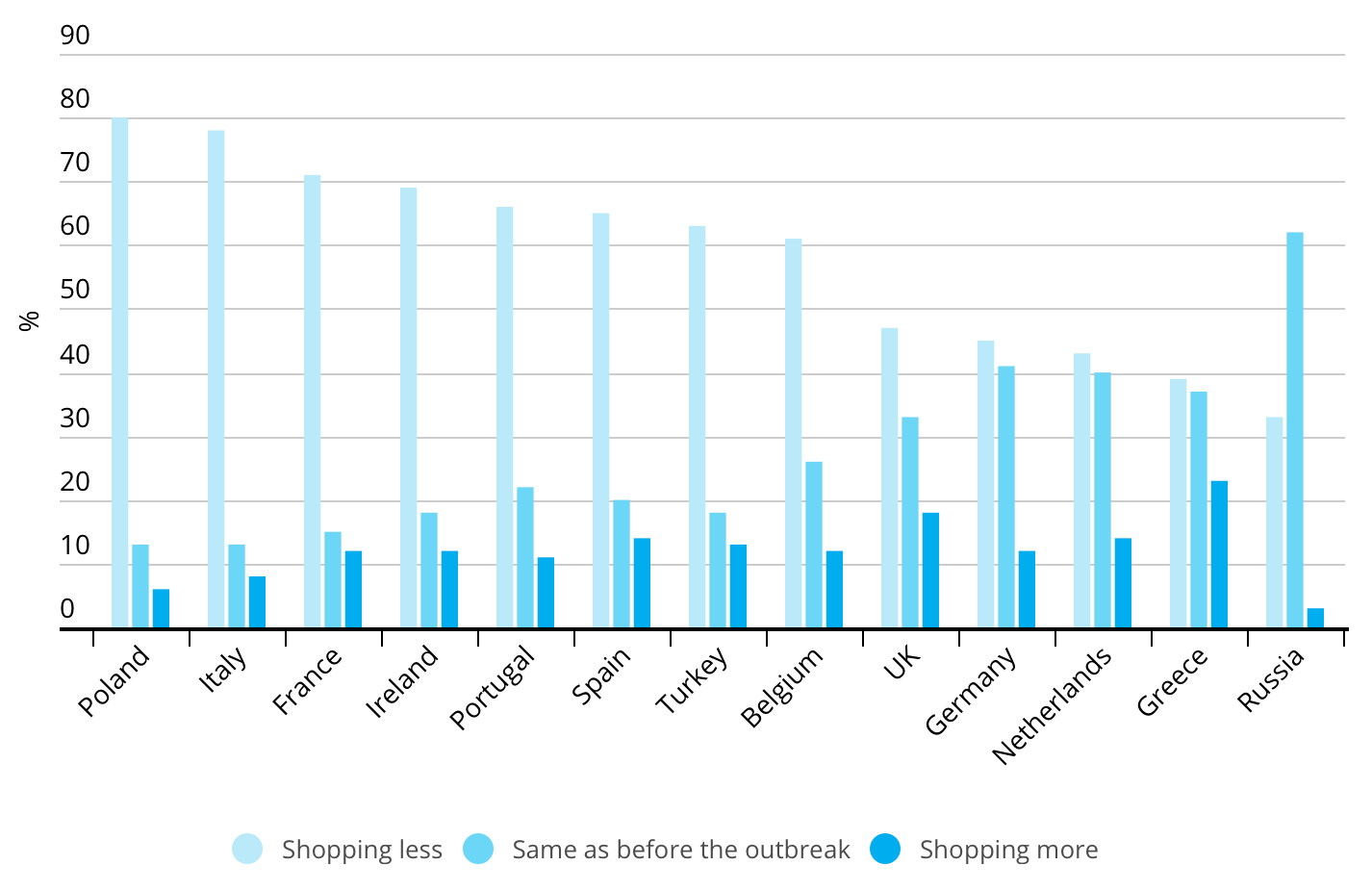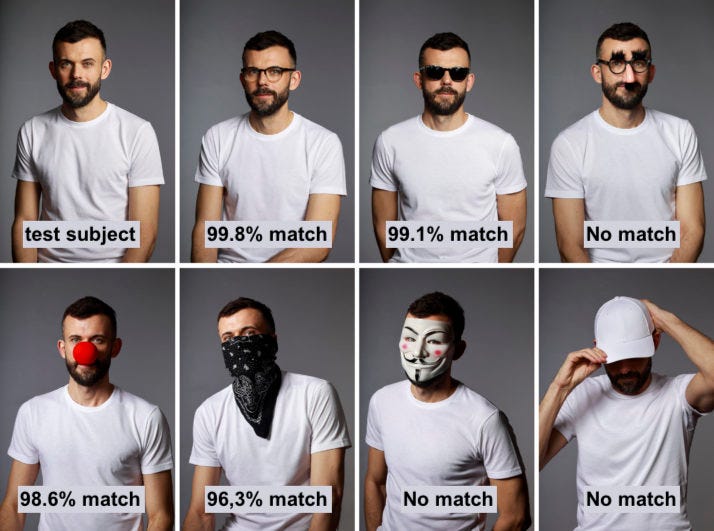Europeans see themselves to be locked up for another year
According to a study by Nielsen, Europeans are staying home and changing their shopping habits already.
Welcome to the FWIW newsletter about tech, media & audio written by David Tvrdon. 🌐 Read it online and 👉 be sure to subscribe, if you were forwarded this newsletter.
In this edition
🇪🇺 Europeans expect to be in lockdown for another year
🛒 Fastest Growing & Declining E-commerce Categories & Amazon affiliate slashes
💬 Other news: Politico put the facial recognition to test; YouTubers are reporting declines in CPM; Apple has a mobility report website; Apple’s new iPhone SE will be sold for $399; News consumption is up, so is misinformation spreading; Ad spend is down; Podcasting ad revenue might be on the rise
Europeans expect to be in lockdown for another year

📷 by Jeff Hendricks on Unsplash

Nielsen conducted a survey of consumers from 29 countries across Europe who were asked how long they think it will last.
The majority of Europeans believe the impact of COVID-19 is here to stay for the next 12 months, signaling that some of the major changes we’ve seen in the consumer and retail environment will stick around as well.
For instance, the majority of consumers in Poland, Italy, France, and Ireland are reconsidering the necessity and frequency of visiting supermarkets and are considering more online alternatives where available.
Change in supermarket shopping 👇 (yes, people go to the supermarket significantly less)

Before the pandemic, a number of EU countries were among the least receptive to online shopping. Consumers were not used to shop grocery items online.
Less than one in five Western European consumers and less than one in 10 Eastern European consumers have ever used these services.
The COVID-19 outbreak represents a change to shopping habits with compelling growth in online sales. For example, online grocery shopping in Italy and France has spiked massively during the COVID-19 period.

With limited options to dine out, more consumers are eating at home. For almost half of consumers in Greece, Germany, the U.K., and the Netherlands, eating meals at home was the norm. But for consumers in countries like Turkey, Italy, Portugal, and Spain, having to adapt to cooking and eating at home more has meant notable shifts in dining routines—and shopping habits.

“Industry players will need to define more seamless online to offline experiences, incorporating things like auto subscriptions to entice consumers to stay online—easing replenishment with routine delivery,” said Johan Sjostrand, President West, Central Europe and Pacific Zone, Nielsen. “Manufacturers will need to simplify home care and cooking regimes to create extended, enjoyable in-home experiences. The longer the COVID-19 environment extends, the more embedded new habits will become and that creates a lot of new opportunities for players that move quickly.”
Ad: One app to rule them all? We shall see
In my latest newsletter I wrote about all the different apps there are for contact tracing across Europe, but the answer should be one (I also introduced the Pan-European Privacy-Preserving Proximity Tracing initiative).
After that a couple of things happened:
Apple and Google announced they are building coronavirus tracking into iOS and Android, which was widely praised, there was also some criticism. Overall the project seems to be a good idea, will see about the execution.
DP-3T has come up as an option. The Decentralised Privacy-Preserving Proximity Tracing (DP-3T) project is an open protocol for COVID-19 proximity tracing using Bluetooth Low Energy functionality on mobile devices that ensures personal data and computation stays entirely on an individual's phone (here is a great explainer by Nicky Case 👇)

EU Commission published the European roadmap that shows the path towards the common lifting of containment measures, and among other, in section 5 the roadmap states: Create a framework for contact tracing and warning with the use of mobile apps, which respects data privacy. Unfortunately, we do not know which approach the EU Commission is going to take, the acknowledged they are aware of the PEPP-PT initiative.

Top 100 Fastest-Growing & Declining Categories in E-commerce & Amazon affiliate slashes

📷 originally by Stackline, edited by me (& my mad PS skills)
According to a Stackline report from the end of March, the e-commerce landscape has dramatically shifted. They reviewed e-commerce sales across the U.S. and compiled a list of the Top 100 Gaining and Top 100 Declining categories.
[🇸🇰 For my Slovak subscribers I recommend this deep dive on the report at MocneData.sk.]
There are some surprises on the rising end (📈 bread machines), also some not so surprising categories in decline (📉 travel accessories).
The big question is, of course, when the crisis ends, how many new consumers will remain loyal to e-commerce. My bet is a lot of them.
The global e-commerce sales have been growing by 4,5% in the last two years, I would say there will be a significant change in YoY this year. One of the many indicators might be that Amazon slashed commission rates for the program that gives publishers a cut of sales.
Rates are being cut for a number of affiliate product categories. For example, the affiliate cut from purchases of furniture and home improvement products has fallen from 8% to 3%, while the commission rate for grocery products has slid from 5% to 1%, according to a document obtained by CNBC.
That’s all kinds of harsh, especially for publishers who have been relying on affiliate revenue from Amazon and spent the last few years building business verticals around this idea.
To be honest, I don’t see Amazon returning those feedback to “normal” even after the crisis. The company has been already hiring thousands of new employees to keep up with the demand. So for Bezos, it makes sense not to push sales also through affiliate if the warehouses can’t keep up. On the other hand, it’s just another reminder the company is too huge.
Top 10 Fastest-Growing Categories
Disposable, Gloves (+670%)
Bread Machines (+652%)
Cough & Cold (+535%)
Soups (+397%)
Dried Grains & Rice (+386%)
Packaged Foods (+377%)
Fruit Cups (+326%)
Weight Training (+307%)
Milk & Cream (+279%)
Dishwashing Supplies (+275%)
Top 10 Fastest Declining Categories
Luggage & Suitcases (-77%)
Briefcase (-77%)
Cameras (-64%)
Men's Swimwear (-64%)
Bridal Clothing (-63%)
Men's Formal Wear (-62%)
Women's Swimwear (-59%)
Rash Guards (-59%)
Boy's Athletic Shoes (-59%)
Gym Bags (-57%)

[Click on the image for the original file.]

In other news
TECHNOLOGY
👺 Politico put the facial recognition to test. The team used a free version of Amazon Web Services’ facial recognition software, Rekognition, to compare the photos to a reference. [Politico.eu]
The results provide striking insights into what today’s facial recognition technology is capable of: Different beards, or the lack thereof, did nothing to conceal Janosch’s identity [the man on the photos]; neither did dark sunglasses or a bandana that covered the complete lower half of his face. Camouflage makeup, which distorted the proportions and symmetry of his face, made it slightly more difficult for the system to identify him, but it still detected enough common features to conclude that both photos show the same person. The only disguises that worked were masks that fully or almost fully covered Janosch’s face — or, surprisingly, Groucho glasses.

💰 YouTubers are reporting anywhere from 30% to 50% declines in their cost per mille (CPM). It’s not a great time to be a YouTuber who is earning the majority of his or her revenue from ads in the videos. The “adpocalypse” in 2017 caused a mass exodus of big business from YouTube. Back then, YouTubers had to look for off-platform income, many turned to services like Patreon. Those who diversified are better prepared for the current situation. (FYI: YouTube takes that money, keeps 45% for itself, and gives 55% to creators.) [OneZero]
🧑🎓 After Google and Facebook, Apple has a mobility report website as well. Reports are published daily and reflect requests for directions in Apple Maps. You can search for a country, region or city (though the city has to be a city, tried to search for Bratislava where I live, but it wasn’t there, not even Prague). [Apple Mobility Trends Reports]

📱 Apple announces the new iPhone SE for $399. This second generation is essentially an iPhone 8 with a better camera, faster processor and a lower price tag. It has Apple’s A13 Bionic chip, the same that’s available in the latest iPhone 11 and 11 Pro models. Few caveats: there is no headphone jack, has a portrait mode with technology Apple calls “monocular depth-sensing”, comes in three colors (black, white, red). So far the tech media is reluctant to say this will be a bestseller, similar to the original iPhone SE. We will see. [The Verge]

MEDIA
ℹ️ News consumption is up, so is misinformation spreading. Reuters Institute for the Study of Journalism has published a new report on navigating the ‘infodemic’. Here is a bit from the conclusion of the report:
We have found that people rely on many different sources of news and information about coronavirus, and access them via many different platforms. News use is up, news organisations remain central, and news media are trusted by a majority in all six countries. Most of our respondents also rely on various platforms, but regard the content they access via social media, video sites, and messaging applications (and to a lesser extent search engines) as much less trustworthy than information from news organisations.
Here are a few concerning points:
On average about a third of respondents say they have seen a lot or a great deal of false or misleading information in the last week.
About one in three also say they feel the news media have exaggerated the pandemic.
Almost a quarter of our respondents incorrectly believe coronavirus was made in a laboratory.
If you don’t have the time to read the whole report, here is a summary in Tweets. [Report]
📉 Digital ad spend is down 33% and traditional media is down 39%. According to an IAB report from the end of March, we know ad-supported media is in trouble. As you can see in the chart below, it’s not just the traditional media that is expected to have significantly lower ad revenue. [IAB report as PDF]

📈 On the other hand, the podcasting ad revenue might be on the rise. As I reported two weeks ago, podcast listening hit a bump with a 10-20% decrease in listening. This seems to take a turnover according to Acast and Megaphone. Of course, nothing is simple and Nicholas Quah of Hotpod writes, that according to data from Podtrac (which broke out the biggest publishers numbers) it seems the large podcast networks are doing very well and the struggle might be on the lower end of the scale, think all these independent podcasters. One more thing, Acast tells TechCrunch that they have seen a lot of new podcasters sign up and start a podcast. [TechCrunch, Digiday, NiemanLab]

🏰 Disney is about to permanently change how it operates. That’s what Bob Iger told associates according to a deep dive by Ben Smith of NYT. On February 25th Bob Iger announced he is stepping down as CEO and Bob Chapek will replace him. It didn’t take long and due to the coronacrisis Bob, the original, is back at the reigns training to save the company. According to the media industry analyst Hal Vogel, Disney is losing as much as $30 million or more a day. [The New York Times]
Mr. Iger is now intensely focused on remaking a company that will emerge, he believes, deeply changed by the crisis. The sketch he has drawn for associates offers a glimpse at the post-pandemic future: It’s a Disney with fewer employees, leading the new and uncertain business of how to gather people safely for entertainment.
💸 Applications for the European Journalism COVID-19 Support Fund open today. The European Journalism Centre and the Facebook Journalism Project have launched a $3 million USD fund to support hundreds of community, local and regional European news organizations. EJC will prioritize providing grants for small and medium-sized news organizations supporting the communities most affected by the crisis. Funding ranges from €5,000 to €50,000. [COVID-19 Support Fund]
OTHER
😊 Sports news got suddenly more mainstream (in a way). OK, this is obviously a bad joke on my part, but watch this SNL sketch on the current sports reporting. It basically tells the story of how sports media has to pivot (I wrote about how sports news was one of the very first casualties). You ask pivot how? Well, towards anything at this point to fill up the coverage due to canceled sports events.
Also, the latest SNL featured a sketch on Twitch and Zoom, and basically the whole edition was a great experiment in filming the late show from several locations.
Catch me on Twitter or LinkedIn. Was this forwarded to you? Subscribe over here👈



